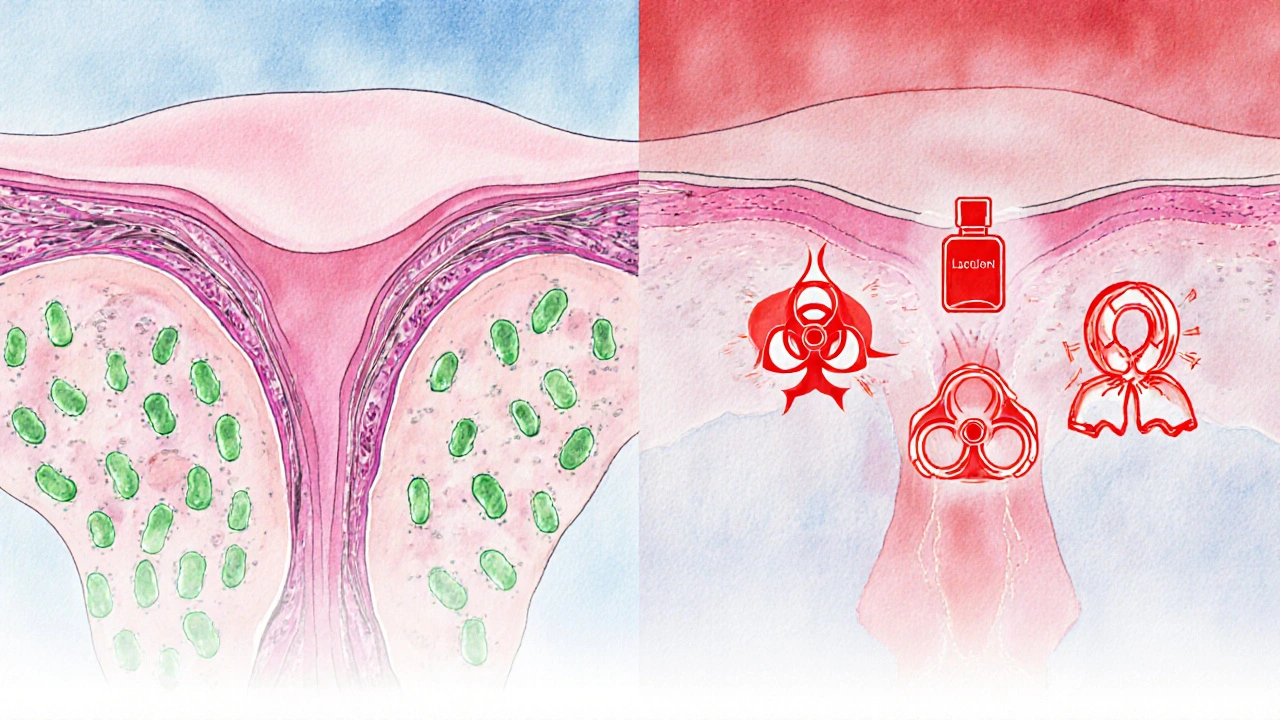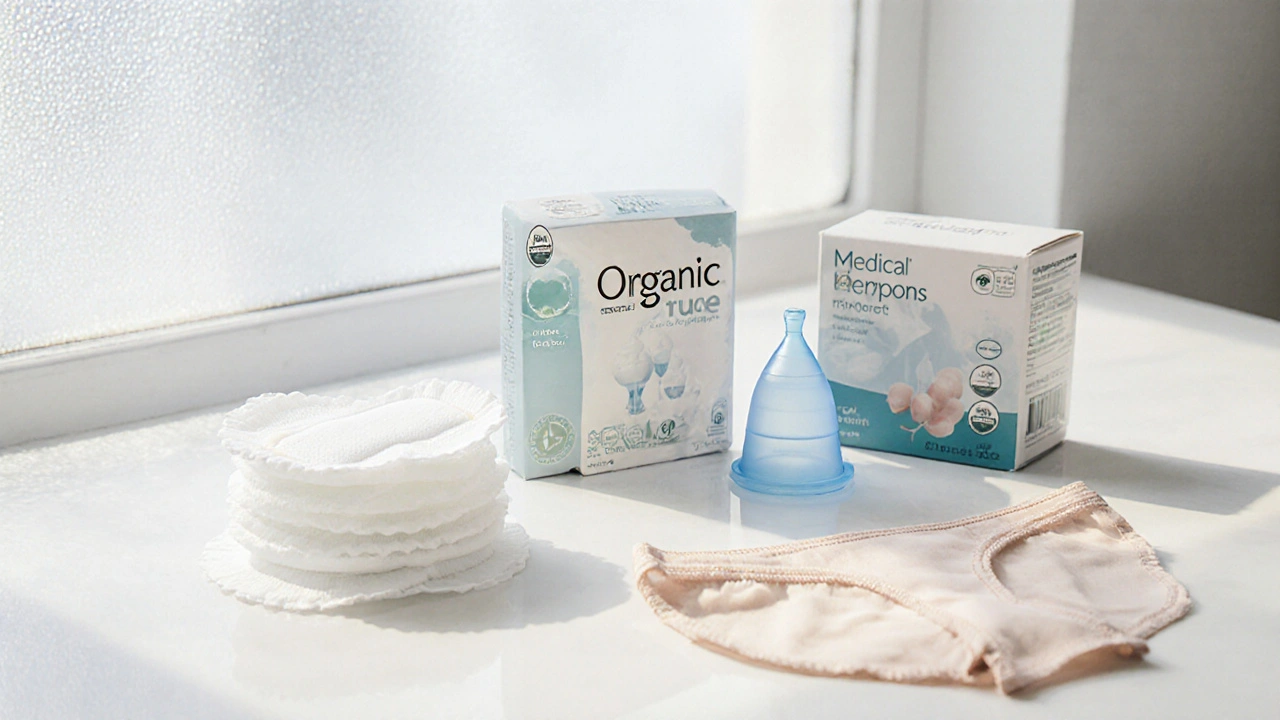Feminine Hygiene Product Selector
Recommended Product
Why This Works for You
Key Ingredients to Avoid
When it comes to staying fresh during your period, feminine hygiene products are essential. Feminine hygiene products include pads, tampons, panty liners, menstrual cups, and period underwear that absorb flow and protect against leaks. Picking the wrong one can leave you with itching, redness, or even infections. This guide will walk you through the science, the ingredients, and the practical steps you need to choose the right product and keep irritation at bay.
Quick Takeaways
- Look for hypo‑allergenic, fragrance‑free, and breathable materials.
- Avoid strong chemicals like chlorine bleach and scented additives.
- Match product absorbency to your flow to prevent excess moisture.
- Test a new product for 2-3 days before committing long‑term.
- Consider reusable options (menstrual cup, period underwear) if you have very sensitive skin.
Why Vaginal Irritation Happens
The vagina maintains a delicate balance of pH (usually 3.8‑4.5) and a healthy community of Lactobacillus bacteria. Anything that disrupts this environment-whether it’s a chemical, a change in moisture, or a physical friction-can trigger irritation.
Common culprits include:
- Perfumes or dyes that strip the natural protective mucus.
- Non‑breathable synthetics that trap heat and humidity.
- Over‑absorbent products that pull too much moisture away, leaving tissue dry.
- Allergic reactions to rayon, polyester, or certain adhesives.
Understanding these triggers helps you filter out products that are likely to cause problems.
Types of Feminine Hygiene Products
Each product class has its own set of materials and design features. Below is a quick rundown of the most common options.
Tampon a cylindrical absorbent made of cotton, rayon, or a blend, inserted into the vagina to collect menstrual flow
- Pros: discreet, high absorbency options, good for active lifestyles.
- Cons: can dry out vaginal walls, risk of toxic‑shock syndrome if left too long.
Menstrual Pad an external absorbent placed in underwear, usually composed of a top layer (often cotton), an absorbent core, and a waterproof backing
- Pros: easy to change, less internal friction.
- Cons: many contain synthetic plastics, fragrance, or chlorine‑bleached fluff.
Panty Liner a thin pad designed for light spotting or everyday freshness
- Pros: thin, comfortable for daily wear.
- Cons: often scented, and the adhesive can irritate sensitive skin.
Menstrual Cup a medical‑grade silicone or TPE cup that folds and sits inside the vagina to collect flow
- Pros: reusable for up to 10 years, no chemicals, maintains natural moisture.
- Cons: learning curve, initial insertion can feel odd.
Period Underwear underwear with built‑in absorbent layers made from fabrics like bamboo or microfiber
- Pros: comfortable, no disposable waste.
- Cons: requires careful washing to avoid buildup of residues.
Ingredients and Materials to Watch
Not all materials are created equal. Here are the red‑flag ingredients that most dermatologists and gynecologists advise avoiding.
- Fragrance - synthetic parfum compounds are a top allergen.
- Chlorine bleach - used to whiten pads, can irritate mucosal tissue.
- Rayon or viscose blends - may contain residual chemicals from processing.
- Latex adhesives - can cause contact dermatitis, especially in people with latex sensitivity.
- Plastic‑based back sheets - trap heat and prevent airflow.
Instead, look for products marketed as organic cotton grown without synthetic pesticides and processed without harsh chemicals or hypo‑allergenic formulated to minimize allergic reactions. Certified certifications (e.g., GOTS) add an extra layer of trust.

How to Test a New Product Safely
Even the most reputable brand can react differently with your unique microbiome. Follow this three‑day trial protocol before adopting a product for the whole cycle.
- Day1: Use the product for a single half‑day (e.g., morning). Observe any immediate itching, burning, or unusual discharge.
- Day2: Extend use to a full day, but keep a backup unscented pad on hand. If irritation appears, switch back and note the symptoms.
- Day3: Continue if the previous days were symptom‑free. If any redness persists beyond 24hours, discontinue and try an alternative.
Document the brand, type, and any sensations in a simple notebook or phone note. This log becomes valuable when you compare multiple products.
Checklist: Choosing the Right Product for Sensitive Skin
- ✅ Is the product fragrance‑free?
- ✅ Does it list organic cotton or medical‑grade silicone as primary material?
- ✅ Is the absorbency level appropriate for your flow (light, moderate, heavy)?
- ✅ Does the packaging mention pH‑balanced or microbiome‑friendly?
- ✅ Are there third‑party certifications (GOTS, FDA‑cleared for cups)?
- ✅ Can you return or exchange if irritation occurs?
Side‑by‑Side Comparison
| Product | Primary Material | Fragrance? | Breathability | Best for Sensitive Skin |
|---|---|---|---|---|
| Organic Cotton Pad | Organic cotton | No | High | ✔️ |
| Unscented Rayon Pad | Rayon blend | No | Medium | ⚠️ (possible chemical residues) |
| Medical‑grade Menstrual Cup | Silicone or TPE | No | Very high (maintains natural moisture) | ✔️ |
| Fragrance‑free Tampon | Cotton‑rayon blend | No | Low (can dry out) | ⚠️ (dryness risk) |
| Period Underwear (Bamboo) | Bamboo fibre | No | High | ✔️ |
Common Mistakes and How to Avoid Them
Even savvy shoppers slip up. Spot the errors below and keep irritation at bay.
- Choosing the most absorbent option for a light flow. Over‑absorbency pulls moisture from the vaginal walls, leading to dryness and itching.
- Switching brands mid‑cycle. Your microbiome needs consistency; frequent changes can destabilize pH.
- Re‑using disposable pads. Once a pad is saturated, the backing can become a breeding ground for bacteria.
- Skipping the trial period. A product that looks perfect on the shelf might still cause a reaction for you.
Next Steps If Irritation Persists
When irritation doesn’t improve after changing products, consider these actions.
- Stop using any scented or chemically‑treated items immediately.
- Switch to a plain, unscented organic cotton pad for a few days to let the area recover.
- Consult a gynecologist-persistent redness, burning, or unusual discharge could signal an infection like BV or a yeast overgrowth.
- Ask the doctor about a probiotic rinse or a pH‑balancing cleanser specifically formulated for sensitive vaginal skin.

Frequently Asked Questions
Can I use scented tampons if I have sensitive skin?
No. Even a light fragrance can trigger irritation. Opt for fragrance‑free, preferably 100% cotton tampons to minimize risk.
Are menstrual cups safe for people who’ve never used them?
Yes, as long as you follow the insertion guide and pick a size that matches your cervix height. Start with a short‑term cup and practice during a light‑flow day.
What does ‘hypo‑allergenic’ really mean on a product label?
It means the manufacturer has reduced common allergens like fragrance, latex, and certain dyes. It doesn’t guarantee zero reaction, but the risk is far lower.
How often should I replace my menstrual cup?
A quality silicone cup can last 5-10years if you clean it after each cycle and store it in a breathable bag.
Is it okay to wear a panty liner all day?
Only if it’s a thin, breathable, unscented liner. Prolonged wear can trap moisture and lead to irritation.







Comments
Cinder Rothschild
1 October 2025When you set out to choose a product that will keep your most intimate area comfortable and healthy you must first understand that the vaginal ecosystem is a delicate balance of pH and beneficial bacteria and any foreign material that disrupts that balance can lead to irritation and infection therefore the first step is to read the ingredient list of any product you consider it is essential to avoid fragrances synthetic dyes chlorine bleach and rayon because those substances are known irritants and they can compromise the natural flora moreover you should prioritize products that are marketed as organic cotton or medical grade silicone as those materials are inherently breathable and hypoallergenic another key factor is the absorbency level you should match the product to your flow intensity light moderate or heavy to prevent over‑absorption which can dry out the tissue and cause itching also give the product a trial period of a few days to see how your body reacts before committing to a full cycle you may find that reusable options such as menstrual cups or bamboo period underwear are gentler on the skin because they do not contain a plastic backing that traps heat and moisture finally keep a simple log of the brand, type, and any symptoms you notice this will help you compare options and make an informed decision that supports your vaginal health over time you will notice fewer flare‑ups and a more comfortable monthly experience
Oscar Brown
2 October 2025One must contemplate the epistemology of hygiene and recognize that the selection of feminine products is not merely a retail decision but an act of self‑care rooted in philosophical prudence; consequently the discerning individual should interrogate the ontological nature of each ingredient, eschewing synthetic fragrance which, in its essence, represents an artificial imposition upon the body's natural state, and favoring instead the authenticity of organic cotton which aligns with the virtue of simplicity. Moreover, the principle of beneficence dictates that we avoid chlorine bleach, for it disrupts the pH balance akin to a malign influence on a harmonious society. In summary, the rational agent will prioritize hypo‑allergenic, breathable materials and will employ a methodical trial protocol to ensure empirical validation of comfort and safety.
Tommy Mains
2 October 2025Pick a product that says "fragrance‑free" and "organic cotton" on the front. Those words mean less chance of itching. Match the absorbency to how heavy your flow is – a light pad for light days, a cup for any flow if you want reusable. Test it for a few days and write down if anything feels odd. If you notice redness, switch to a different brand. This simple plan helps keep irritation away.
Alex Feseto
3 October 2025It is incumbent upon the erudite consumer to discern the subtle gradations between quotidian disposable wares and their more sophisticated counterparts, for the latter are oft‑crafted from premium, breathable fabrics that honor the sanctity of the delicate mucosal environment; thus, one ought to elevate one's selections beyond the pedestrian and embrace the rarefied offerings of medical‑grade silicone, which, unlike the vulgar synthetic back‑sheet, preserves the natural moisture equilibrium.
vedant menghare
3 October 2025Greetings, dear reader! As a cultural ambassador I cherish the diversity of menstrual experiences across the globe, and I must say that the most harmonious products are those that respect the body’s innate wisdom. Choose items that celebrate nature – think organic cotton pads that feel like a gentle whisper and silicone cups that sing in harmony with your pH. Avoid the cacophony of fragrance and chlorine; they are like discordant notes in a beautiful symphony. Remember, the journey to comfort is a pilgrimage, and each thoughtful choice is a step toward radiant well‑being.
Kevin Cahuana
4 October 2025Hey, just wanted to say that switching to a fragrance‑free pad was a game‑changer for me. I noticed less itching right away. If you’re trying something new, give it a couple of days and see how your skin reacts. It’s all about listening to your body, no pressure.
Danielle Ryan
4 October 2025Listen up!!! The secret they don’t want you to know is that most mainstream pads are laced with nano‑particles that track your cycle!!! They’re designed to push you into endless consumption!!! Choose only organic, fragrance‑free options or you’ll be feeding the system!!!
Robyn Chowdhury
4 October 2025One might argue that the pursuit of the perfect pad is a Sisyphean task, yet the evidence suggests that fragrance‑free organic cotton offers a modest respite from irritation. 🤔
Deb Kovach
5 October 2025👍 Great guide! Just a reminder: always check for a GOTS certification on organic cotton pads – it guarantees they’re pesticide‑free. And if you go for a cup, make sure it’s medical‑grade silicone. 🌱
Sarah Pearce
5 October 2025im super suuper happy!!! this is sooo helpful!!!
Ajay Kumar
6 October 2025Hey there! Just wanted to add that keeping a small diary of what you try can really help you spot patterns. If a certain brand gives you a rash, note it down and avoid it next time. Stay comfy!
Richa Ajrekar
6 October 2025The article correctly identifies fragrance and chlorine as irritants, but it fails to mention that many "organic" claims are unregulated. Readers should verify certifications before trusting such labels.
Pramod Hingmang
7 October 2025Choosing a product that breathes is like letting a garden breathe – it thrives. Opt for silk‑soft, fragrance‑free pads or a silicone cup to keep the natural balance humming.